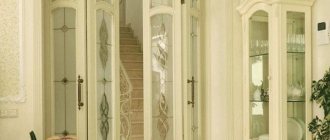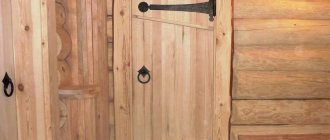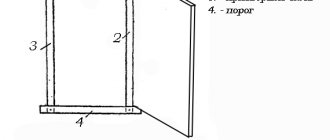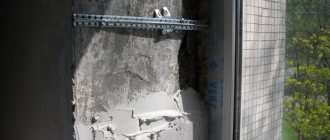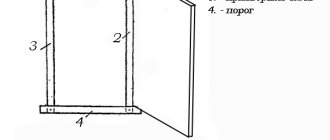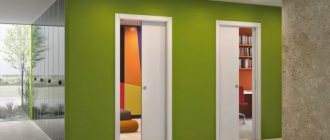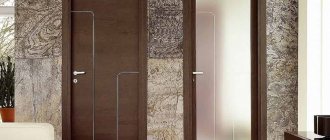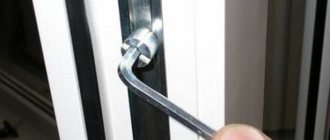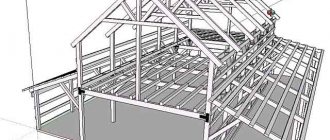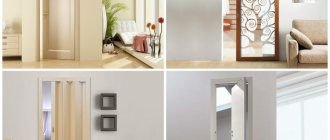Few owners are able to boast that they can even play football in their apartment or house. More often, owners of their own homes are forced to fight to win every centimeter from their “small land”. All means are used; one of the most effective solutions is to replace a conventional hinged interior door with a more compact design. In this case, many people choose the universal option - folding. The desire of people to save money on repairs has not surprised anyone for a long time, so a do-it-yourself accordion door is a great way to solve two problems at once: save money and get a practical thing that fits best into the interior.
There are pros, but what about cons?
Such interior doors consist not of one leaf, but of several parts, the width of which is often in the range of 100-150 mm. They are connected using hinges or hinges. When opening and closing, the elements move along guides, often installed at the top of the opening. The folding door against the wall actually looks a lot like an accordion bellows. However, in addition to the original appearance, this design has other advantages. These include:
- significant savings in space, the lack of which is especially painful in apartments with narrow corridors;
- relative ease of manufacture: even an amateur can cope with the task, and the process itself will not take a lot of time;
- versatility, since the design can open in any direction, will not close from drafts, and is silent;
- “omnivorous” - the ability to install an accordion door in any room of the apartment or house: between living rooms, in the bathroom, shower stall;
- easy width adjustment, since removing/adding a sash when changing the opening width occurs quite quickly;
- relative invisibility when folded;
- low manufacturing costs.
Having assessed the “bouquet” of advantages of the original accordion door, now you need to get acquainted with its disadvantages:
- if the opening is not too wide, then the folded structure will make it even narrower;
- The “musical instrument” is not durable and unshakable: in the event of force majeure, the accordion can be accidentally knocked out of the guides;
- good heat and sound insulation - qualities that are unusual for it.
If, after thinking about the advisability of changing doors, the advantages of the accordion still outweighed, then you can move on.
DIY accordion door step by step instructions
How to make and install an accordion door yourself
If you want to save not only your own money, but also free space, there is an excellent solution - a do-it-yourself accordion door. It can serve not only as a full-fledged door, but also as a decorative screen and used for zoning rooms.
The accordion door is a great solution for saving space
Design Features
To understand the question of how to make and install an accordion door with your own hands, you need to delve deeper into the features of this simple design. At its core, it is a folding mechanism consisting of individual small-width flaps connected by hinges or hinges.
Unlike ordinary doors, the accordion does not open wide, but folds to the side. It is driven by a special roller mechanism, which is most often located above the canvas. Special synchronizers ensure smooth and uniform movement of the sashes. To ensure that the design does not have defects, it is recommended to purchase fittings and other components from specialized construction or furniture stores.
The main structural elements of an accordion door
Basically, an accordion door has only one direction of movement, however, if its side part is not secured, the door leaf can be moved both to the left and to the right. In large doorways, it is more reasonable to install double models; they differ from double doors only in that they do not open in a hinged manner, but fold like an accordion.
Advantages and disadvantages
Due to the many differences between an accordion door and a regular door, the advantages and disadvantages of this design should be highlighted. You definitely need to start with the advantages:
- saves space;
- allows you to zone the space;
- can be used as a shower screen;
- low cost;
- can be easily made by yourself;
- does not slam shut due to drafts;
- you can adjust its size;
- almost silent when using a high-quality sliding system;
- can be automated.
The accordion door is not only practical, but also carries a serious decorative load
However, such a door is not without its drawbacks:
- when folded, it takes up space in the opening, narrowing it;
- short-lived;
- less durable than normal;
- has low thermal insulation properties;
- does not contain noise well;
- it can be knocked out of the guides.
In some cases, the disadvantages may seem too significant. Weigh all the factors: evaluate the operating conditions of the door, the expected load on it, climatic conditions, the noise level in the house, and then the picture will become clearer, and you will be able to decide whether you need just such a product.
What materials are the doors made from?
Before you decide to make an accordion door yourself, you should decide on the type of material for its manufacture. The fabric of such a product consists of individual lamellas. The base can be made of the following materials:
- Natural wood . This material is quite durable and can last a very long time, but only if it is properly processed. Before using it in a door structure, the wood must be impregnated with an antiseptic, covered with stain and varnish. The protective coating will need to be renewed periodically. With constant changes in humidity and temperature, wood can deteriorate, especially for soft wood;
- MDF . This is a pressed fibreboard, which is characterized by high strength and wear resistance. This is an ideal option for interior doors, and it is not susceptible to mold or mildew;
- Chipboard . Cheaper material, which naturally affects its characteristics. At its core, these are sawdust compressed and glued together. Such a door cannot boast of a strong fastening. Higher quality samples are closer in cost to MDF, so it is better to immediately purchase a more reliable material;
- Plastic . In interior openings such material will not look very aesthetically pleasing. Plastic is characterized by low cost, ease of processing, water resistance and durability. This is an ideal option for a shower stall.
Basic materials for making sashes
You should choose the appropriate material depending on the installation location and the functional purpose of the future door.
Preparation of materials and tools
To make an accordion door you will need the following materials:
- slats,
- loops,
- hinged guides,
- pen,
- lock,
- side connecting profiles,
- plugs,
- guide,
- rollers,
- self-tapping screws
The width of the slats depends on the wishes of the master himself; for a standard door, 5-6 strips are enough. In order to make door leaf elements from a single sheet of material, it is necessary to measure the width and height of the doorway, taking into account future fastenings. The end part is sanded with fine sandpaper, then the edges are edged; it can be easily attached to a clean surface with an iron, since it has an adhesive base.
An approximate set of accessories for making an accordion door
Manufacturing instructions
So, let's look at step-by-step instructions for making an accordion door with your own hands. The process will consist of several stages:
- Lay out all the elements of the future door on the floor. Determine which lamellas will be the outer ones and secure them in the side profiles;
- Mark the location of the hinges and drill holes for their fastening. Install the hinges using self-tapping screws;
- Place hinged guides over the joints to disguise the hinges;
- Place plugs on the lower edge of the lamellas, and additionally screw the wheels on the upper edges. It is recommended to place heavy doors on additional rollers from below;
- If there are no errors in size and the door fits perfectly into the opening, all that remains is to embed the lock and handle.
- Inexpensive.
- Easy to make.
- Allows you to change the size.
- They don't take up much space.
Step-by-step visual instructions for installing an accordion door
The recommended width of the gap between the joined sashes is 3 mm, this helps eliminate restrictions on the movement of the leaf. If wide elements are used, the number of loops must be increased, since the weight of the parts is greater than when using narrow slats.
Door installation
Once the canvas is ready, you can begin its installation. First you need to install a guide; it is attached to the upper horizontal bar of the loot. If desired, you can install special stoppers on the lower guides.
Accordion door installation diagram
The next step is to install the canvas. Place the wheels into the guide and lock the door in a vertical position. To prevent the accordion door from moving from side to side, one edge of it is fixed to the bar using a joining profile.
Self-installation of an accordion door can be done independently without any problems
As you can see, installing an accordion door in a doorway is much easier than a regular one, and the process of making the door itself will not take much time. The variety of materials allows you to create unique products. To make the structure lighter, instead of blind doors, you can use lamellas with glass inserts. For screens, parts with decorative through carvings or lattice are suitable. To save even more space, the door can be inserted into the wall, completely or partially; this is possible for plasterboard structures that are hollow inside. Which model to create is up to you to decide.
Need a master? Professional craftsmen will perform any work Order repairs
How to make and install an accordion door with your own hands (video)
One of the main principles of modern design is the delimitation of space. This division can be carried out either in one room - using furniture and decor to designate different functional areas - or between several. In this case, the doors come to the fore.
In this article we will tell you about folding accordion doors, how to assemble and install them with your own hands with instructions and videos.
Folding doors: pros and cons
This solution is most often found in small apartments. Narrow corridors, small hallways and kitchens. And every meter counts. For them, folding doors are a great way to optimize space, because they:
Doors of this operating principle serve equally well as a regular door, a shower screen (in this case they should be made of plastic) or a cabinet door.
Of course, they also have obvious disadvantages that are a consequence of their design. When folded, it narrows the opening. They are less strong and durable compared to a regular swing door. Although they do not open from a draft, they do not retain heat in the room well. Almost no noise protection. Requires careful use.
However, even taking all this into account, the possibility of zoning space with their help has long been appreciated. Now they have begun to appear on the pages of design magazines as key design elements. Many designers resort to them when creating stylish and vibrant images.
Design
Folding doors can be divided into two types:
Image from website: mdm-mag.ru
- Accordion door. It consists of several canvases 10-15 cm wide, connected with hinges or a hinged profile.
Image from website: dverlife.ru
- Book door. It is made of two movable doors. Often, for greater reliability of the mechanism, a lower guide is also used.
They have one way of functioning, but due to their characteristics, each type uses its own fittings.
To better understand how to make an accordion door yourself, let's look at the principle of its operation. When opened, the door folds to the side rather than sliding or swinging open. It moves using a roller mechanism, usually located above the canvas. Uniform and smooth movement of the remaining doors is ensured by special synchronizers.
In the video you can see the principle of operation of the mechanism.
Necessary materials and components
You can make a sliding accordion door with your own hands from:
- Solid wood. Durable, environmentally friendly material. The disadvantages are sensitivity to moisture, and for a design of this type – weight. When using solid wood, you should choose more durable fittings. If you use cheap wood, it should first be treated with an antiseptic and the finished door should be varnished.
- Chipboard (chipboard). Cheap, relatively durable material. Veneer coating allows you to create a pleasant look. It is not afraid of moisture, but is not convenient to use; due to the texture, the screws do not hold well in it.
- Fiberboard (MDF). It's more convenient. Allows you to achieve sufficient fastening strength, lightweight, fireproof, resistant to water, safe from an environmental point of view.
- Plastics. It is inexpensive, durable, moisture resistant, and does not dry out. Does not require special care, easy to clean. An argument in its favor is its light weight. The weight is its disadvantage, as it creates a feeling of unreliability.
Image from site: stroychik.ru
- Glass in a metal frame. Folding doors made from it are used to visually expand the space. Tempered glass provides a wide field for experimentation. It comes in different colors, transparency, and patterns. But working with him is difficult.
So, the necessary materials:
- Sheet material 16-20 mm thick or lamella.
- Rollers.
- Top guide.
- Rotary axes (upper and lower).
- End hinges or hinge profile.
- Pen.
- Lock.
- Plugs.
- Fasteners
To ensure that your structure serves you well and for a long time, purchase fittings and components from specialized furniture and construction stores.
Making and installing accordion doors with your own hands: step-by-step instructions and video examples Preparatory work
- Let's prepare the opening for installation: remove the old door frame, knock down the mortar to the brickwork or concrete wall. Optional step. You can leave everything as is, this solution will significantly simplify and speed up installation, but you will significantly narrow the opening. Which is not recommended for folding doors.
- A box without a threshold is made from the extras. Carefully insert it into the opening and fix it as firmly as possible using bars or wedges. We need it to not bend during subsequent fastening.
- We drill and fasten our box with long anchor bolts. 3-5 attachment points on each side. We foam all the resulting gaps between the frame and the wall.
Door leaf installation
Image from website: mirrestavracii.ru
And finally, let's move on to the question of how to make folding accordion doors with your own hands.
- Based on the dimensions of the resulting box, we mark out the sheet of material from which we intend to make the panels.
- If you are making from wood or its derivatives, sand the end edges with No. 0 sandpaper. We wipe away dust. We glue the edges at the ends.
- We are waiting for the parts to stick. This usually takes more than 12 hours.
- We mark the installation points of the fittings.
- On the outer panel, in the marked places, we make a hole for the metal axles (bottom, top). We fix the axes.
Remember, the metal axes must be positioned symmetrically.
- On the panel that is supposed to be the last one, we install a roller runner.
- We lay the canvases on the floor or table in the way they are supposed to be connected.
- We place three loops between the panels. Place loops of the same level at the same height. Otherwise, they will be skewed and cracks will appear on the canvas. (Or if instead of hinges it was supposed to be connected with side hinge profiles, then at this stage you need to connect the panels with their help).
- Fasten the panels so that when the door leaf is fully opened, a three-millimeter gap remains between them.
- On the corresponding panel we cut out a groove for the handle.
Installation of a door in a frame
Image from website: dveridoc.ru
Let's look at how the accordion door is attached:
- Install the guide rail. We drill holes in it for attachment to the jamb. Step 25-30 cm. We screw it at one end, so the guide can move.
- We mount the latch: insert the end panel axis into it and insert the carriage runner into the rail.
- We hang the sash. It needs to be folded, lifted, and then the metal axles inserted into the landing plates.
- We completely attach the guide.
- We attach the outer blade to the carriage axis. We adjust the location of the valves and their movement with a special adjusting key.
When the future door is wider than 1 m, install several more runners at the top and bottom of the opening and make a support. Why is there a bottom rail at the bottom of the box where the wheels of the carriage, mounted on the panels, go.
Completion of work
When you have secured, adjusted and checked everything, install the fittings on the door leaf. Install the trim and that’s it – your door is ready.
In this video you can see how to install factory-made plastic interior accordion doors with your own hands.
Another video on how to install a plastic accordion door.
The interior accordion doors that are installed in this video are also factory-made.
We hope that with our help you can easily and quickly make and install folding doors.
Author: Nika Kaneva
How to make an accordion door with your own hands quickly and correctly
Now there are a huge number of different types of doors that are installed inside the home. They are made from a variety of materials and have both their advantages and disadvantages. In recent years, accordion doors have become quite popular and in demand.
Such demand is primarily due to numerous positive qualities, which we will consider below. You can easily buy such a door ready-made in any specialized store or order it from a workshop.
But if you wish, you can easily do it yourself. To do this, you only need some tools, as well as the necessary materials and desire.
It will be indispensable as a decorative screen to fully carry out zoning of the room. Let's look at how to make an accordion door with your own hands.
Advantages
Accordion door in the interior
The door design is not complicated at all. It includes several parts, ranging from 10 to 15 centimeters wide.
The design is somewhat reminiscent of blinds, but the fastening is done using slats, vertically.
When such a door opens, its parts begin to move along the guide, attached from below and above, and eventually fold up against the wall, resembling accordion bellows.
This design has numerous advantages.
Positive aspects of an accordion door:
- Easy to manufacture. Anyone can make it if they wish. It won't take much time or effort.
- It is very compact. This property is indispensable for small apartments with narrow corridors. By installing such a door, you will be able to save a lot of free space.
- For manufacturing you will need the simplest tools and materials
- This door is versatile. It opens easily in the direction you want.
- If necessary, the width can be quickly and easily changed. To do this, you just need to add or remove a few parts.
- The accordion door is equipped with a special latch. This is necessary to avoid accidental opening. The latch is installed directly on the guide.
- The accordion doors open and close almost silently.
- If the door is made of moisture-resistant materials, for example, plastic, it can be installed, for example, in bathrooms or shower rooms. They will look great in them and, due to their compactness, will save free space.
- The door cannot be opened by drafts, thanks to the mechanism installed on it.
That is, to summarize, the accordion is compact, perfect for the interior of any room, and if it is in the folded position, it is almost invisible. Thanks to the large selection of colors, you can easily find exactly the one that is most suitable for you and which will best fit into the interior of your house or apartment.
But, at the same time, the accordion door also has some disadvantages. This is, first of all, a short period of use and poor resistance to various impacts. By accidentally touching it, you can easily damage this structure.
As we can see, there are numerous advantages. outweigh the existing shortcomings of the door. This has a positive effect on its popularity and demand.
Required materials
Most often, doors are made of chipboard. It has such positive qualities as excellent sound insulation, resistance to regular exposure to moisture and good heat retention. We will conduct a master class on how to make an accordion door with your own hands and what materials are needed for this.
In the video you can see about the accordion door in interior design:
If you intend to make it yourself, you can use the following materials:
- Quite often such doors are made of wood. This material is environmentally friendly, durable and strong. But a lot depends on the type of wood. If you are going to use coniferous varieties, then you will need to open the surface with varnish and apply a special antiseptic substance to it. All this will increase the operating time of the door. But wood has poor resistance to moisture and should not be installed in bathrooms and showers, as it will quickly become unusable.
- MDF is very suitable due to its many beneficial properties. First of all, it is light in weight, has good strength, and is resistant to fire and moisture. In addition, this material is environmentally friendly. By installing an accordion door made of MDF, you can rest assured that all sorts of bacteria and mold will appear on it.
- Chipboard is a fairly durable, but relatively cheap material. If you intend to make an accordion out of it, then do not forget to apply veneer on top. This material is perfect for installation in rooms where it will be regularly exposed to moisture. But you may have problems when attaching the hinges - the screws screwed into the chipboard do not hold very well and often, over time, pop out.
- Glass is often used for accordion doors. But what is required is tempered glass. The door can be installed in any room. It will fit perfectly into almost any design. But it is quite difficult to process tempered glass yourself, and if you decide to buy ready-made glass, be prepared for the fact that its price is quite high.
- Plastic has a long service life and low price. Having made a door from PVC slabs, you can be sure that there will be no scratches or cracks on it. Plastic is highly resistant to moisture. She is the material. It has good sound insulation properties and perfectly retains heat in the room.
If you intend to make an accordion door yourself, then you should choose the material depending on the room in which you intend to install it and being guided by your financial capabilities. You can easily find everything you need in specialized stores.
In addition to the material, to install the door you will need fittings, which include frames, hinges, carriages equipped with runners and stoppers. All these parts are also very easy to buy.
Also, don't forget the PVC edge and screws. All this is easy to find. The color of the edge should be the same as the door itself. It will be necessary for its cladding.
To make opening a door convenient, its design must have at least one leaf. In this case, the first lamella is attached to the opening, and a roller is installed on the second, allowing the doors to move smoothly along the installed guides. To fix it in one position or another, special clamps are used - flags.
Everything you need can be easily purchased. The choice of material depends only on you.
Self-production
The photo shows how to make an accordion door with your own hands.
Accordion door diagram
Making a door includes the following steps:
- The first step is to mark the material and cut out two parts from it that act as flaps. They may be the same or different in width. It depends only on your imagination. If they are not made of glass, they will need to be carefully sanded. After this, wipe with a rag and stick the edges to their ends. Don't forget to press them well with a roller. so that they sit tightly and leave in this position for a day.
- After waiting until the applied glue dries well, you should put marks on them where the connecting carriages and hinges, lock, etc. will be located. Next, pins are installed on one end from the bottom and top. To do this, you need to drill holes to the required depth. Runners are installed on top. This will also require making holes.
- Having done all of the above, place both parts on a flat surface and fasten the hinges. They need to be installed in threes. They must be mounted at the same level. This is required to avoid displacement of the valves during further operation. Leave a gap between the wings. But it should not be more than 2-3 mm.
- A groove is made on the outer panel for installing a handle. It is installed on the last part of the door. A groove is made in the middle for attaching the lock. When the doors are completely ready, they can be attached to the fasteners installed in the doorway.
Required tools and accessories
As mentioned above, in order to make a door with your own hands, you will need to have the necessary tools and materials for this.
- All necessary accessories
- Guide
- Material
- Edge
- Electric drill
- Glue
- If you need to enlarge the doorway, use a hammer drill
- You will also need a jigsaw, preferably an electric one.
- Hacksaw
Pencil and everything needed for accurate measurements
Accordion glass doors
By installing a door, you have the opportunity to increase the free space in the room.
It can be either with one leaf or with two.
A door made of tempered glass will look great.
But doing it yourself is very difficult and will require additional tools and practical skills.
If you intend to install such a door in the bathroom, then choose a material that is resistant to moisture.
This way you guarantee not only attractiveness, but also a long service life.
As we can see, making an accordion door does not require special skills or overly complex tools. It's quite simple.
The main thing is to choose the right material from which you will make them, accurately take all the necessary measurements and correctly connect and secure the doors.
The door is accordion when used carefully and depending on the material used. can serve you for many years without losing its attractive appearance and all its positive properties.
Its price will be quite reasonable, because basically, everything necessary for its production is inexpensive. That is, if you decide to make an accordion yourself, you can save a lot by getting an excellent door.
- Do-it-yourself suspended ceiling, step-by-step instructions Do-it-yourself suspended slatted ceiling: step-by-step instructions When finishing ceilings, consumers often choose slatted…
- Installation of a split system with your own hands (instructions) Stages of installing a split system with your own hands Outdoor unit of the air conditioner
- How to install a door with your own hands? Video instructions for installing a door I would like to offer you several training videos on how to install doors yourself. Thanks to the video...
- DIY decorative fireplace step by step instructions DIY decorative fireplace: step by step instructions February 1, 2015 Fireplaces have long been used as a source…
Selection of material for sashes
For folding fabric slats, there are several worthy candidates.
Tree
This material is a “favourite of the public”, as it is environmentally friendly, “beautiful in appearance”, strong and durable if it is correctly treated with an antiseptic, stain, and varnish. When choosing wood, you must take into account that the procedure for applying a protective coating will need to be repeated from time to time. Otherwise, changes in temperature and humidity will do their dirty work.
Chipboard
Chipboard is sawdust, compressed and glued together, so reliable, durable fastening with self-tapping screws to such doors is out of the realm of fantasy. The material is cheap, but to build an accordion door it is better to purchase either the highest quality chipboard or give preference to another contender.
MDF
For example, this one. Fiberboard, which has a medium density, differs from its previous competitor in more impressive indicators of moisture and wear resistance, strength, and fire resistance. Despite the environmental friendliness of the material, it is not afraid of the “living” threat - the colonization of microorganisms. Another advantage is light weight.
Plastic
This is a worthy opponent to other materials, but only in one category. We are talking only about “musical” doors in the bathroom - in the shower stall. Pros: price, ease of working with the material, durability, lack of “respect” for temperature changes and high humidity. The downside is the unaesthetic appearance of interior doors made of PVC.
Tempered glass may be on the list of candidates, but this choice is not very practical. It is deterred by its high price and the difficulty of processing narrow elements at home.
Advantages and disadvantages
The accordion door saves space and is therefore suitable for mini-houses
The design has an unusual appearance and structure. The same can be said about the method of opening it: a weak push provokes the movement of the panels along the guide, usually located on top. They fold against the wall, resulting in a position resembling an accordion. The advantages of the design include:
- ease of use;
- saving space (when arranging furniture, you do not need to focus on it not being touched by the door);
- ease and speed of installation - both a finished structure and in the case of independent creation from scratch;
- possibility of use in bathrooms and other places characterized by high humidity (subject to the correct choice of material);
- option to change the direction of movement of the elements (for this you need to swap the side flaps).
Among the disadvantages of the accordion, one can note its rather weak resistance to impacts. The structure is easy to handle, but it must be done carefully.
Preparatory activities
Having determined the type of material you like, calculate the required quantity before purchasing. To construct an accordion door for a standard opening, 5-6 elements are enough. The height and width can be easily calculated independently after measuring the parameters of the opening, but future fastenings must also be taken into account.
In addition to lamella panels, they buy or find in “bins”:
- horizontal rail;
- plugs, lock with latch;
- PVC edge, glue;
- sandpaper;
- profiles - side, guide, docking, hinged;
- rollers, handle;
- self-tapping screws
The following will help you cope with the task faster:
- drill and set of drills;
- ruler, tape measure, square;
- pencil (marker);
- hacksaw, jigsaw.
Project selection - stage one
Operation DIY Accordion Door starts with him. Correct measurements and calculations will allow you to create the perfect drawing. But no one forbids you to find a ready-made scheme that is easy to adapt if the opening in the apartment/house is non-standard. The structures are divided into:
- single-leaf, classic models, in which the assembled leaf moves entirely;
- double-leaf accordion doors are doors that have two parts, their sides move from the center to the jambs.
The latest designs may have an unequal number of sashes, so each master is free to choose any modification. However, single-leaf models are the most popular, since their production guarantees a minimum number of difficulties along the way.
The width of the accordion slats is the second stop for consideration. Wider doors save space in the doorway when folded. Narrow ones, on the contrary, save space indoors. If the opening is not impressively wide, then wide bellows are the best option.
How does a folding door work?
It is quite possible to make such a door with your own hands, but first you should understand in detail the features of its design and the principle of opening and closing.
A flip door consists of two door panels (driver and slave), which are connected to each other by a special mechanism consisting of the following mandatory components:
- mortise hinges;
- driven door roller;
- lower and upper supports of the drive door, as well as the rotary axles to them;
- fastener
The described mechanism allows, for example, instead of one wide door 80 cm wide, to install two narrow folding door leaves of 40 cm each. In this case, the permissible load on it should not exceed 40-60 kg (depending on the manufacturer), that is, it cannot be mounted on such a mechanism heavy metal, glass or armored doors.
The principle of operation of this design is that one panel is clamped into the spacer between the floor and the upper guide, and the second moves freely on a roller.
Construction of the door leaf
Markings are applied to the sheets of material according to the drawing. The doors are cut out, all edges are carefully sanded with sandpaper, and wiped off dust with a dry cloth. Glue PVC edges onto the edges and leave the parts to dry for a day.
- On the sashes, places for mounting the carriage, rollers, fittings for the axle, lock, handle and hinges are marked. The minimum number of last fasteners is 3; if the accordion door consists of a large number of wide leaves, then this number is increased. The outer ends of the outermost elements are not touched. The canvases (in pairs at first) are laid horizontally, making sure that there is not the slightest displacement.
- Fix the hinges with self-tapping screws, having previously drilled holes of a slightly smaller diameter in the fastening areas. There are no particular difficulties with this operation, but there is a main requirement: the minimum gap remaining after fastening the parts must be 3 mm. This applies to an accordion that is completely closed.
- They are working on the leaf that will be attached to the door frame. Holes for axial pins are drilled in it from the bottom and top; their depth is less than the length of the pin. These parts are put on, then the rollers are fixed on top of the sashes. Grooves for the lock and handle are cut out on the last lamella.
The almost finished door is put aside and the next operation begins.
Preparing the opening, installing the door
The first step is to install the guide rail. If necessary, cut off the excess length with a hacksaw and make holes for self-tapping screws. The fastening pitch is 250-300 mm.
- Before installing the accordion, a latch is installed; its rightful place is on the side from which the door will open. Then the axis of the end lamella is inserted into this element. The leaf flaps are folded, and the axial pins are fixed into the landing plates. All fasteners, including rollers, are inserted into the guide rail. The entire structure is attached to the opening. Then a receiving plate is attached in the corner under the lower axis. The main requirement is to be flush with the latch mounted on the rail.
- To adjust and adjust the position of the door wings, use a special adjusting wrench to tighten or loosen the end nuts located on the axles and guide. The number of rollers determines the width of the opening. If this parameter is more than 1000 mm, then it is better to increase the number of wheels. In some cases, it is recommended to add a bottom rail. The rollers are installed on the outer sash, then they are inserted into the guide.
- If the opening is too wide, you cannot do without installing a stopper flag on the bottom rail, which will allow you to fix the door in any position. Standard narrow accordions do not need such elements, because they are usually closed or opened completely.
Do-it-yourself accordion door is an operation that can be done by a home craftsman without much experience. However, it is better to have a clear example before your eyes, which will help better than any set of letters. For example, this video may be useful:
Door installation
The last stage is the actual installation of the door. First you need to install the upper guide; it is attached to the upper transverse strip of the box. Ideally, it can be cut into the core in such a way that there is only a gap of a couple of millimeters between the canvas and the box. Then, the pre-assembled folding door must be provided with runners; for a double-leaf door, this part is attached at the upper end from the outer edge. To limit movement on the opposite side, an additional screw is installed on the rail.
Folder door installation diagram
To insert the blade into the guide, you need to press the runner wheel and squeeze it into the rail lubricated with grease. You can do this even before the final fixation of the elements in the box. By the way, it is not necessary to use a roller mechanism; you can get by with just hinges, but this will significantly weaken the structure.
Lastly, the handle and lock are inserted; this is done in the same way as for conventional sliding doors. Also don't forget to install platbands. At this point the installation process can be considered complete.
